
The content for this blog has kindly been supplied by animal health specialists MSD. MSD Animal Health offers veterinarians, farmers, and pet owners the widest range of pharmaceuticals and vaccines, available in more than 50 countries. Offering one of the industry’s most innovative portfolios, not only of products, but also of services and technologies, to prevent, treat and control diseases across all major farm and companion animal species.
Summary
- The pasteurella is the biggest killer of sheep.
- If ewes are vaccinated correctly, the lambs will obtain antibodies through the colostrum (first milk), which will give them protection for the first month or two.
- Heptavac-P Plus is the recommended vaccine for breeding stock, providing optimal aid in the control of the predominant clostridial diseases.
- The timing of the booster is critical, getting the booster date wrong could mean having to start the primary course for ewes again, adding costs and delaying full protective immunity.
- On farms where the incidence of pasteurellosis is high, a supplementary 2ml booster injection using Ovipast Plus maybe required.
Why vaccinating your Ewes is important?
Vaccinating your flock should be a standard procedure as it produces immunity and reduces the risk of major sheep killers such as, pasteurellosis and colostridal diseases.
The pasteurella pneumonia bacterium is carried on nearly all sheep’s tonsils, yet is the biggest killer of sheep; animals succumb to infection when stressed or if their immunity is compromised in any way. Equally, the organism that causes clostridial-disease is widespread and found in the soil. Both diseases can strike without warning and are often fatal.
If ewes are vaccinated correctly, the lambs will obtain antibodies through the colostrum (first milk), which will give them protection for the first month or two. Vaccinating lambs at marking acts as a sensitising or priming dose that stimulates the lambs’ immune system to protect for approximately 6 weeks.
Pasteurellosis and clostridial disease vaccines are cost-effective and work well to prevent losses. Giving a booster vaccination* to the ewe with HEPTAVAC® P PLUS helps give young lambs the protection they need until they can be vaccinated themselves.
During October 2015 there was an increase in diagnoses of pasteurellosis in unprotected lambs caused by Mannheimia haemolytica or Bibersteinia trehalosi. The project also recorded a large early spring peak of pulpy kidney disease in lambs. A recent postmortem study at a Fallen Stock Collection Centre (FSCC) has also recorded sheep producers are also losing too many lambs to pasteurellosis and clostridial diseases like pulpy kidney. In almost all cases these were young lambs (two to eight weeks old) and neither the dams nor the lambs had been vaccinated
* Ask one of our SQP’s for more advice on helping to protect your sheep against pasteurellosis and clostridial disease.
How does vaccinating ewes increase productivity and welfare?
Lambs taking in high levels of immunoglobulins (from the colostrum) end up healthier and faster-growing, with fewer losses in those critical first weeks of life. One study has shown that lambs out of Heptavac-P Plus vaccinated ewes were all found to have protective levels of antibodies circulating in their blood 5-10 days after birth. This increases their immunity against certain clostridial diseases.
A second study revealed how lambs from vaccinated ewes were free from pasteurella when blood tested after being challenged at 2, 15 and 20 days of age. Lambs from unvaccinated ewes tested positive.
Why should I choose HEPTAVAC® P PLUS?

Heptavac-P Plus has been developed following research and development which resulted in the application of Plus 'IRP' technology for the manufacture of the Pasteurella components of this vaccine. Heptavac-P Plus is the recommended vaccine for breeding stock since it provides optimal aid in the control of the predominant clostridial diseases in adult sheep by active immunisation and in young lambs by passive immunisation.
Active immunity will last for up to 12 months, and that passive immunity will persist for up to 4 weeks after birth in lambs from ewes vaccinated with conventional Pasteurella vaccines. Active immunity to the clostridial diseases is expected to persist for up to one year, with passive immunity being present up to approximately 3 weeks after birth in lambs from ewes vaccinated with Heptavac-P Plus.
When should I vaccinate?
The timing of this booster is critical, getting the booster date wrong could mean having to start the primary course for ewes again, adding costs and delaying full protective immunity.
For optimum protection, it is important that the interval between either:
(1) starting the primary course of Heptavac-P Plus (which comprises 2x2ml doses 4-6 weeks apart) and the annual booster, or
(2) between boosters, does not exceed 12 months.
Vaccination of ewes with clostridial vaccines prior to lambing gives protection to lambs for up to 12 weeks.
A recommended immunisation schedule:
Basic immunisation:
Breeding sheep: All breeding sheep must receive two injections, each of 2ml, separated by an interval of 4-6 weeks. In adult breeding ewes, the second 2ml dose should be administered 4-6 weeks prior to lambing. The pre-lambing booster vaccination must be given 4-6 weeks before lambing - when a ewe is making colostrum. The ewe produces antibodies in response to vaccination, and vaccination increases the concentration of these protective antibodies in her colostrum. These pass to the newborn lamb when it suckles giving it ‘passive’ protection which lasts until the lamb can itself be vaccinated from three weeks of age with Ovivac-P® Plus. Lambs: Lambs being retained for fattening or subsequent breeding will require a full course of vaccination. At a minimum age of 3 weeks these lambs should receive two injections, each of 2ml Heptavac-P Plus, before weaning and separated by an interval of 4-6 weeks. After 12 weeks or postponing until Autumn, increases the lambs risk dramatically of Pasteurella and clostridial attack, particularly pulpy kidney, due to the stress of weaning and change in diet.Re-vaccination scheme:
A 2ml booster injection at intervals of no more than 12 months. In adult breeding ewes these yearly booster injections should be given 46 weeks prior to lambing. Autumn Ewe replacements: As far as autumn ewe replacements are concerned, assume the worst-case scenario regarding their history and vaccination status. Treat them as though they have not received anything then they won’t be missed. They can be treated similarly to breeding ewes, with a full primary course of two injections of 2mls of HEPTAVAC® P-PLUS 4-6 weeks apart when they come into the flock, followed by a booster 4-6 weeks before each lambing, along with the older ewes.Vaccination recommendations:

- On farms where the incidence of pasteurellosis is high, a supplementary 2ml booster injection using Ovipast Plus maybe required 2-3 weeks prior to expected seasonal outbreaks.
- The vaccine bottle must be shaken well before use.
- The vaccine may be administered using a sterile needle and syringe, providing a fresh sterile needle is used each time the rubber cap is punctured, to avoid contamination of the remaining contents.
- Syringes and needles must be from gamma-irradiated packs or freshly sterilised by boiling for at least 20 minutes.
- No alcohol or other disinfectants should be used for sterilisation.
- The use of an automatic vaccinator is recommended.
